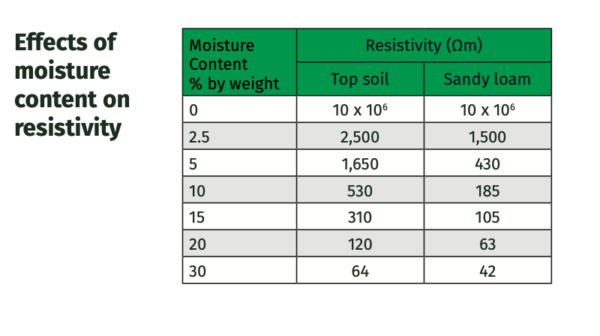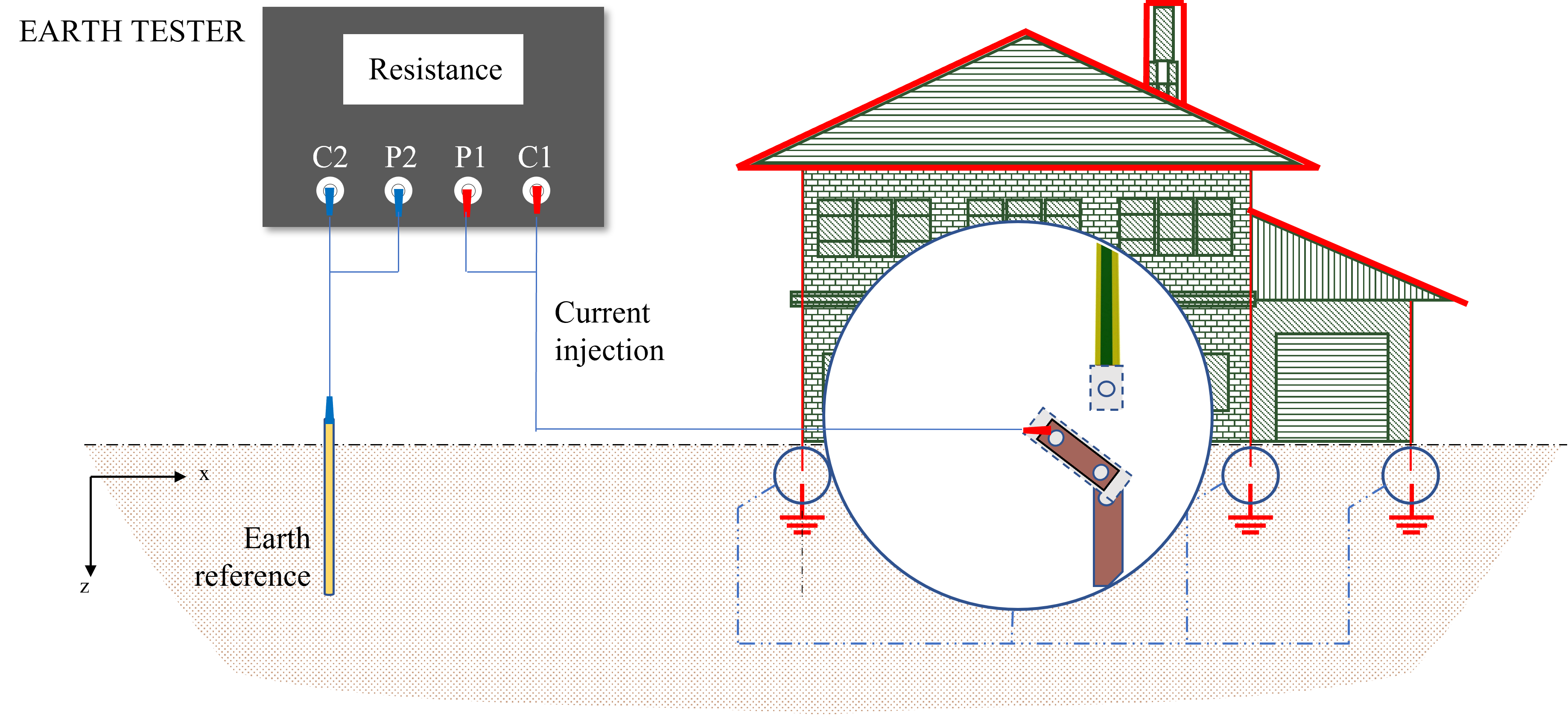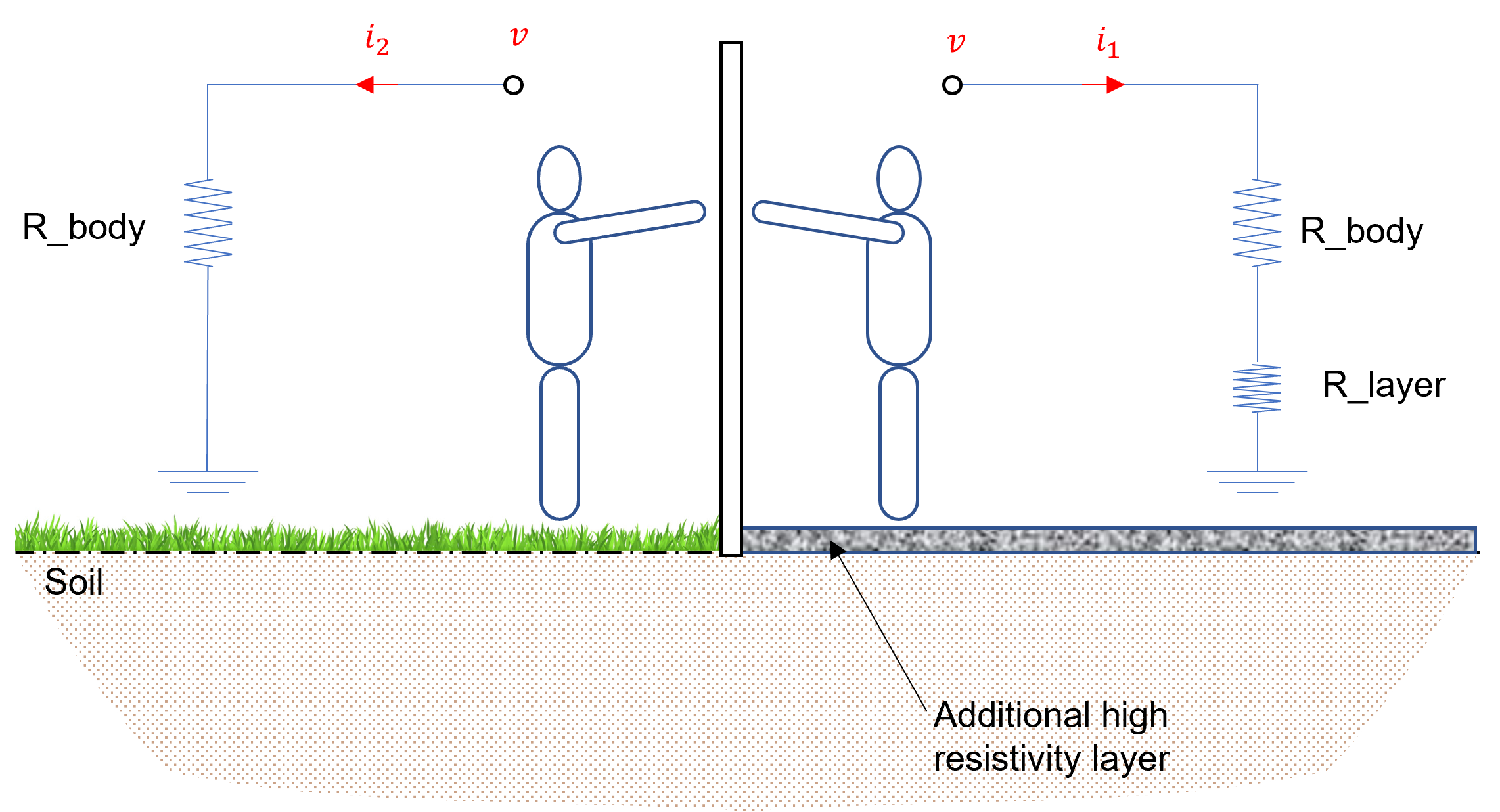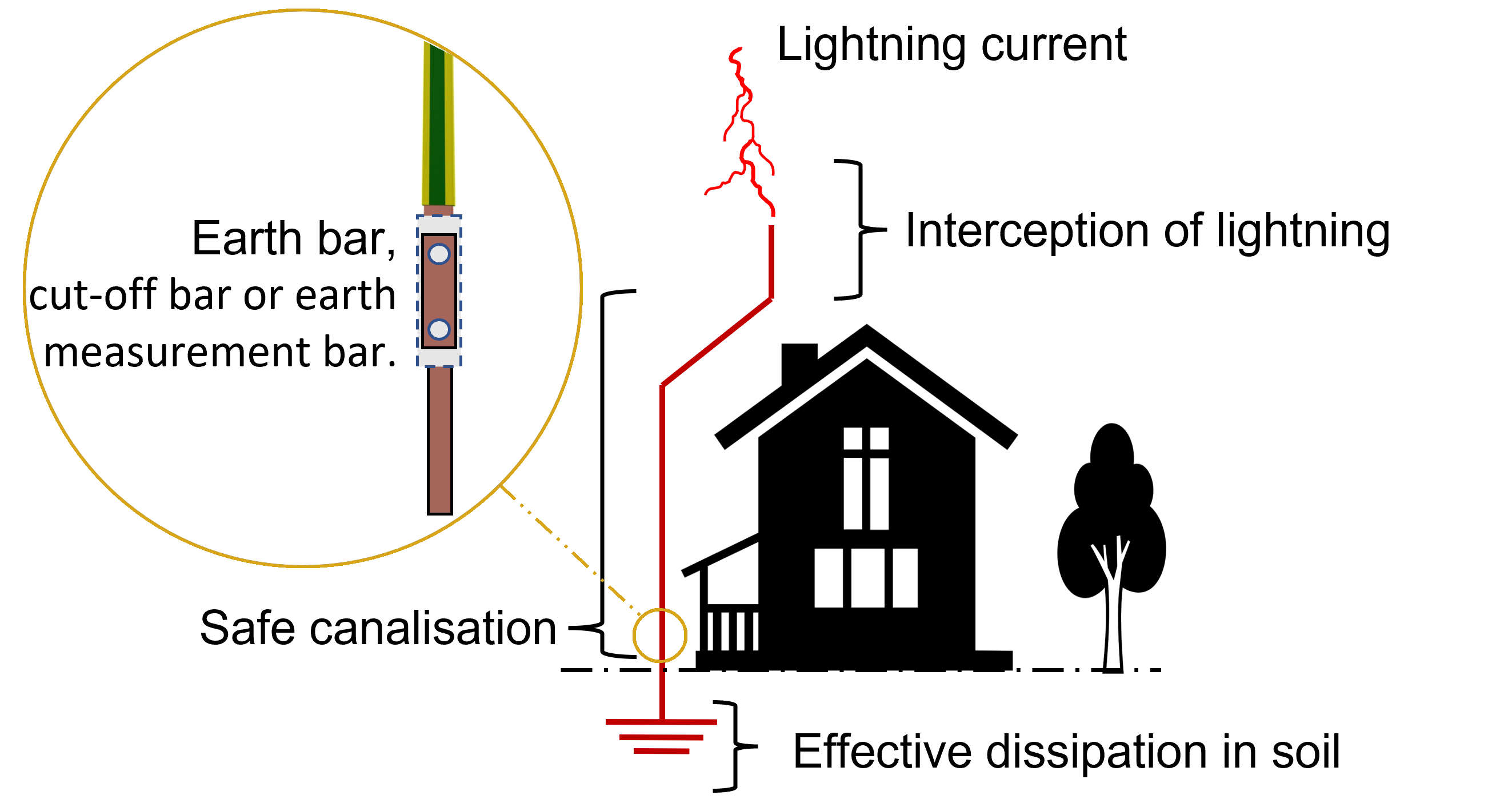I am struggling to achieve the earth resistivity that I need, can a conductive aggregate help me?
The purpose of an Earth Termination Network also known as an Electrode System is to:
- dissipate electrical faults by providing a low impedance pathway,
- dissipate high energy safely from lightning strikes,
- provide a voltage reference level, and
- maintain a constant low impedance path without fluctuations during different seasons of the year.
The Earth Termination Network must:
- allow circuit protection devices to operate correctly,
- provide a low resistivity pathway,
- carry high currents repeatedly,
- protect life, and
- have a long-life expectancy that is resistant to corrosion.
An Earth Termination Network is the physical means through which an electrical fault current or lightning discharge injects into the soil. The ability of the soil to conduct an electrical current HUGELY impacts the performance of an Earth Termination Network. The cost of installation through dictating how much material, drilling, or trenching is necessary to install an effective system.
Soil types, not only vary throughout the world but change within a few meters. The composition of the soil as well as its method of installation can affect the outcome of system. With that in mind, we need to account the following factors when we design our Earth Termination network.
Temperature
 Ion activation within the soil increases with temperature and can significantly impact the performance of an earth electrode.
Ion activation within the soil increases with temperature and can significantly impact the performance of an earth electrode.
As the temperature of the soil changes throughout the seasons of the year, it is important to take into account the worst case weather scenarios.
Hot climates or Summers may potentially dry the soil, making it harder to achieve the required electrode resistivity.
Moisture Content
Resistivity of the soil decreases when the water content increases. The electrical current in the soil is mainly electrolytic and based on the moisture held within the pores of the soil. The significant factors here are:
- Height of the water table,

- Presence of permanent moisture,
- Seasonal rainfall, and
- Amount of rainfall.
For example, well-drained, sandy soil or desert conditions have higher soil resistivity than wet clay.
Structure of the Soil
The structure, compaction, density, depth and porosity of the soil impacts the conductivity of the soil.
Soil with a high resistivity means that the designer needs to use more materials to achieve the desired end result. While copper prices continue to increase, we would rather use less than more.
Chemical Composition
The chemical composition of the soil impacts its ability to conduct electricity. The quantity of “Chemical Salts” in the soil helps improve and lower resistivity, but on the other hand, greatly increases corrosion of metal, shortening the life of the Earthing System. Clearly, the latter is not desirable.
The more adverse the soil type is, the more Earth Electrode material is needed. A larger and more extensive earth electrode system incurs additional installation costs in the forms of:
- Deep drilling for earth rods,
- Extensive trenching for longer lengths of conductors, and/or
- More physical space becomes necessary, and the plot of land might not allow the installation of a large earth electrode system.
Given the cost of copper and labour these days, contractors and clients frequently ask,
“How can I obtain the required earth electrode system resistivity, in the face of high resistivity soil,rocky areas?”
Our solution is simple and at hand in the form of a Conductive Aggregate.
Conductive Aggregate (CA) also known in the electrical industry as: Ground Enhancement Material (GEM), Ground Improvement Material (GIM), Soil Enhancement Material (SEM), Conductive Backfill Material (CBM) should always:
- Be naturally inert – It must not pollute, nor corrode the metallic electrode system,
- Provide a low a stable resistivity,
- Maintain a low resistivity 365 days per year without fluctuation,
- Not leach out or dissipate into the greater mass of soil due to movements of ground, water, and rainfall, and
- Be economically viable in contrast to any additional costs of materials and manpower.
Kingsmill Industries offers two basic types of Conductive Aggregates: Bentonite and Marconite.
The principle behind how a Conductive Aggregate works is that it effectively increases the surface area of the metallic earth electrode by encasing it in a highly conductive medium. Therefore, the Conductive Aggregate increases the surface area of the electrode in contact with the greater mass of the soil and reduces the earth electrode resistivity reading by up to 50% (dependent, of course, upon proper application).
Bentonite and Marconite have respective advantages and disadvantages, but the best overall performance material that we recommend at Kingsmill, is Marconite. We explain our reasons below and throughout the article.
| Bentonite | Marconite | |
|---|---|---|
| Chemically Inert | YES | YES |
| Relies on the Permanent Presence of Water | YES | NO |
| Low Resistivity of Material | Only When Wet | YES |
| Maintenance Free | NO | YES |
Where scoring in GREEN is GOOD.
Marconite is more expensive than Bentonite, but it offers a permanent maintenance fee solution. It also is better suited to dry and arid climates.
Bentonite, on the other hand, is a lower cost product, but what people tend to not be aware of is that it relies upon the presence of permanent moisture which is impacted by climate and dry conditions. This being the case requires frequent maintenance and follow ups, increasing your costs from a maintenance perspective.
Bentonite
Bentonite clay is a natural clay containing Montmorillonite, a mineral formed from ancient volcanic activity.
The low resistivity of Bentonite stems from the electrolytic process between water, soda, potash, lime, magnesia, and other salts that ionizes to form a strong electrolyte with a PH of 8 to 10.
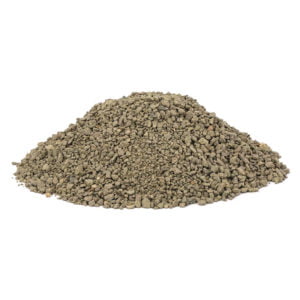
Bentonite clay is also very hydroscopic. It has excellent water absorption properties, and can absorb up to 5 times its dry weight in moisture and swell up to 18 times its dry volume. Sodium Bentonite swells more than Calcium Bentonite and has better water absorption properties. At Kingsmill, we supply Sodium activated Bentonite.
Bentonite relies upon moisture to provide a low resistivity medium, and to obtain it, it uses the natural environment’s soil and rainfall. It is important to be aware that it can dry out, if the material is not receiving enough moisture. Please also be aware that water table levels can fluctuate in height and this can become an issue.
When Bentonite dries out, it shrinks away from the earth electrode and causes high resistance. Bentonite is inert and does not leach out, but in contaminated soil, there is a risk the electrolyte (swollen layer of hydrated Bentonite) could crack and shrink, due to the presence of Chlorine in the surrounding soil.
Marconite

Marconite is a granular, Carbon material that is both low resistivity and high in strength.
Unlike Bentonite, Marconite is “electronic” in that it conducts electricity (electrons) in the same way that metal does. Marconite does not dry out. This is where the performance of Marconite as a Conductive Aggregate, rises above that of Bentonite, which tas we explained previously, relies upon the presence of water and salts to conduct electricity (charged ions).
Marconite does not dry out; it is inert, and has inherently low resistivity (0.001Ωm vs 3Ωm for Bentonite). It is not adversely impacted by seasonal climate variations, nor does it rely upon the presence of moisture or rainfall.
When mixed with Portland Cement, Marconite forms a block of concrete that has the added benefit in today’s world of “Theft Prevention”. It is much harder to remove concrete encased in copper than it is to pull a copper cable from the bare earth.
Conclusion
Both Conductive Aggregates help achieve a low resistant Earth Termination Network reading, but Marconite is the best all-around performer. It is maintenance free and especially good for use in dry and arid conditions. For more information about our Conductive Aggregate products, check out our catalogue: Kingsmill Catalogue.
Application
So, now that we have made it clear which Conductive Aggregate is the most appropriate to use, let’s talk about installation. The application guidance applies to both Bentonite and Marconite.
There are two basic applications. The key here is to always remember that a Conductive Aggregate works by effectively increasing the surface area of the metallic electrode that it is encasing.
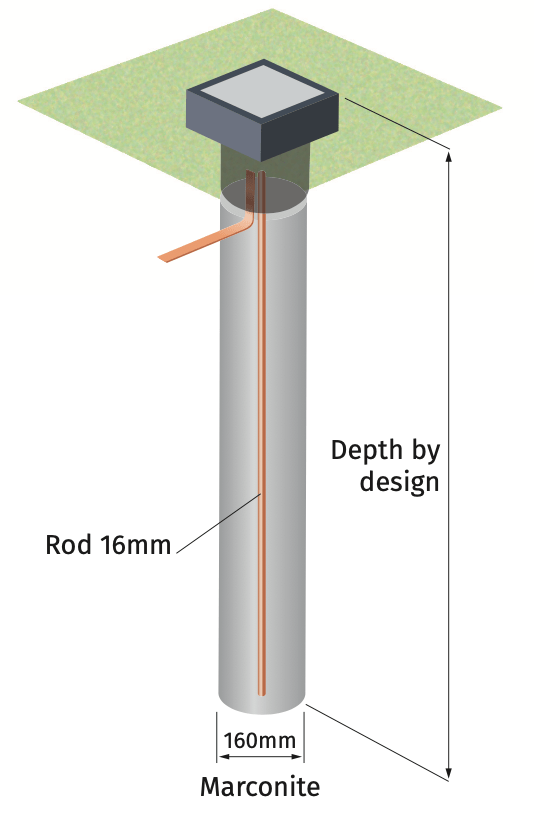
Earth Rod Installation
- Drill a hole 10 x the diameter of the earth rod (16mm diameter rod = 160mm diameter hole)
- Centre the earth rod in the hole and lower it to the bottom
- Mix Marconite® into a slurry and pour into the hole
- Tamp down the mix during pouring to exclude air pockets
- Keep the earth rod central to the hole
- Take a resistivity reading immediately after installation and again 14 days later
Trench Installation (plate/mat)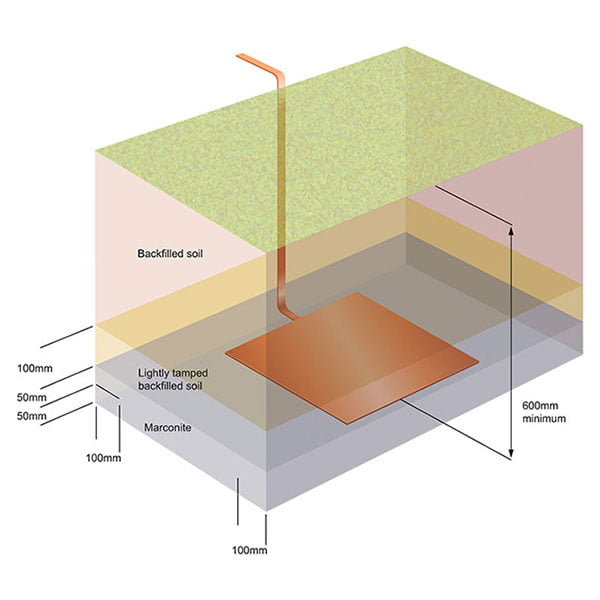
- Excavate a trench to approximately 200mm larger, all round than the plate dimensions. The trench should typically be 1,000m deep (minimum 600mm)
- Mix the Marconite® into a slurry and pour into the trench to a depth of 50mm
- Connect the earth plate/mat to the connecting conductors
- Place the earth plate/mat on top of the first layer of Marconite® mix
- Cover the earth plate/mat with a second layer of Marconite® mix to a depth of 50 mm
- Backfill the trench with native soil to a depth of 100 mm and lightly tamp down
- Then backfill the trench according to the clients requirement
- The use of marker tape or tiles might be required
- Take a resistivity reading immediately after installation and again 14 days later
Trench Installation (conductor)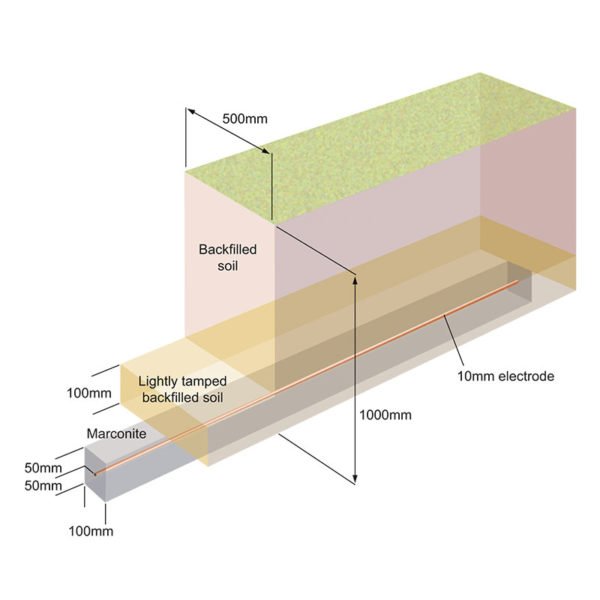
- Excavate a trench, typically 1m deep and 0.5m wide. The length of the trench is determined by the resistivity of the native soil and the system requirement
- At the bottom of the trench excavate a small channel minimum dimensions 100mm wide and 100mm deep
- Mix the Marconite® into a slurry and pour into the channel to a depth of 50mm
- Lay the conductor on top of the first layer of Marconite® mix
- Cover the conductor with a second layer of Marconite® mix to a depth of 50mm
- Backfill the trench with native soil to a depth of 100mm and lightly tamp down
- Then backfill the trench according to the clients requirement
- The use of marker tape or tiles might be required
- Take a resistivity reading immediately after installation and again 14 days later
Make sure to also check our pieces regarding reducing earth resistivity and our guide to measure soil electrical resistivity
For any further questions, please don’t hesitate to reach out to us at [email protected]. Or contact us through our website to submit a query.


